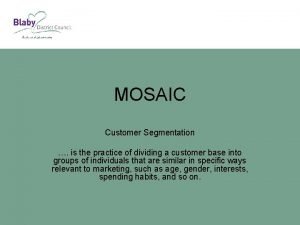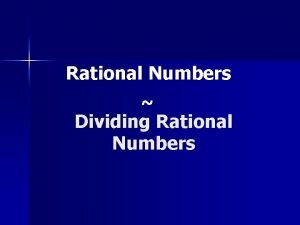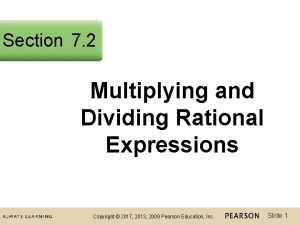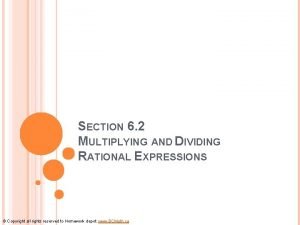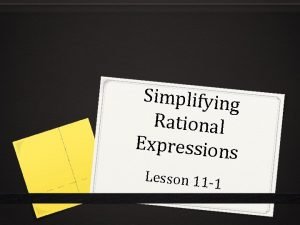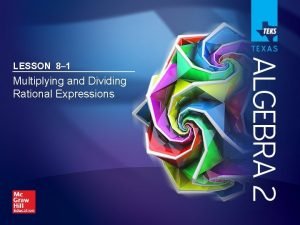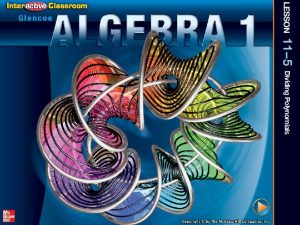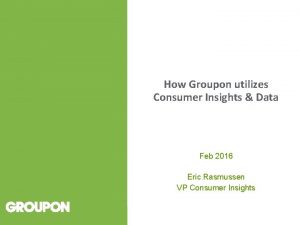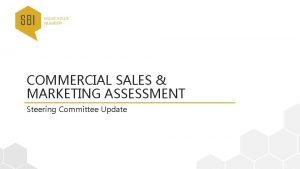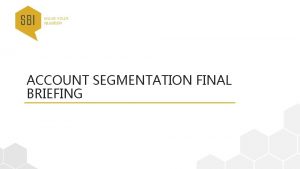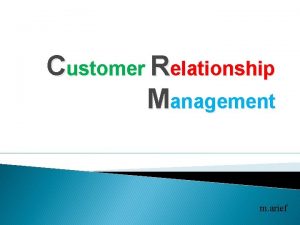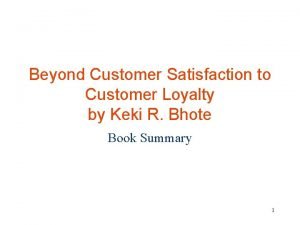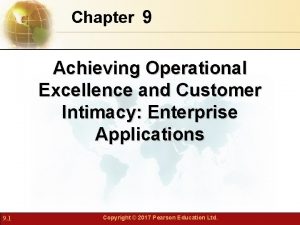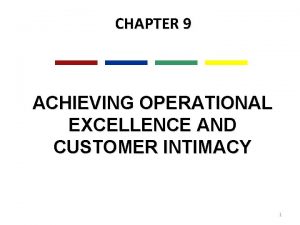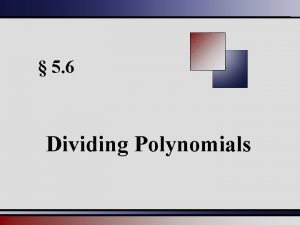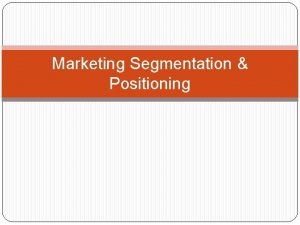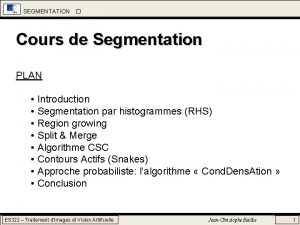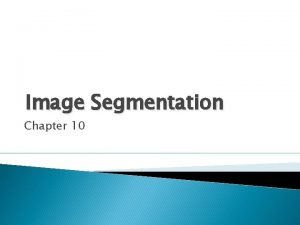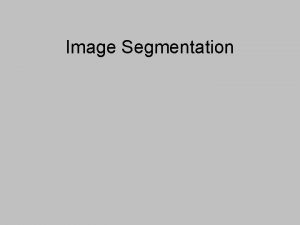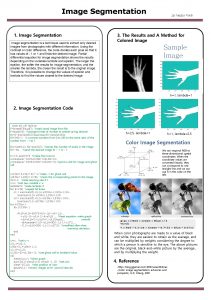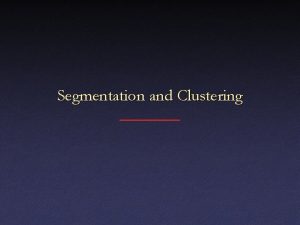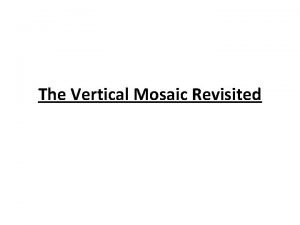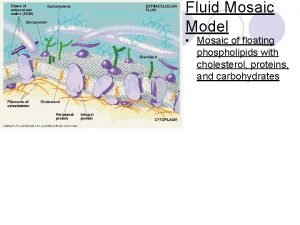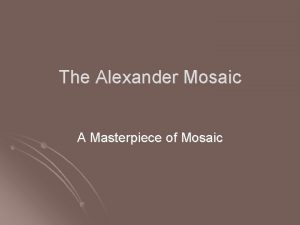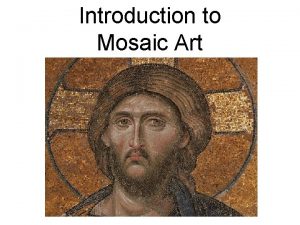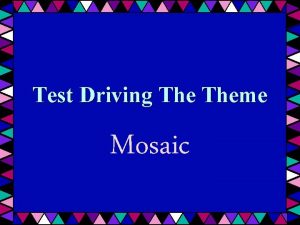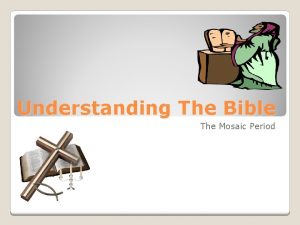MOSAIC Customer Segmentation is the practice of dividing


















- Slides: 18

MOSAIC Customer Segmentation …. is the practice of dividing a customer base into groups of individuals that are similar in specific ways relevant to marketing, such as age, gender, interests, spending habits, and so on.

What is it? • Mosaic Public Sector classifies all UK citizens on the basis of their needs for public services. Divides customers by characteristics and puts them into groups. Characteristics such as health, how many children, how many cars, buying behaviour, are they ‘green’, what leisure/sport activities they like etc • 69 household types [groups (1 -69)] aggregate into 15 categories (A-O), to create a description that is applied at a household or postcode level.

Interactive Guide http: //www. publicsectorknowledgebase. co. uk/loginpage. aspx Classifications and Groups. Helps you to identify and understand the characteristics of people.

Interactive Guide

Overview of the district Identifying all the types of groups of people who live in the district

Blaby • Blaby is estimated to contain 38, 918 households • Of these, there are 4 distinct customer groups that dominate: – Group E – Middle income families living in moderate suburban semis (23. 44%) – Group B – residents of small and mid sized towns with strong local roots (19%) – Group J – Owner occupiers in older style housing in ex industrial areas (14. 56%) – Group F – Couples with young children in comfortable modern housing (14. 04%)


Family Tree

Summary - Group E 19

Pen Portrait You can use Pen Portraits to help answer questions such as: How should I communicate with my customers? What should the tone of the message be? What is our message to them? What other messages do we need to be communicating to that group? Could we combine multi-messages so we only communicate with this group once?

Why use MOSAIC? • Understand your current customers – who are they? • Target households for specific service communications (eg. Local newspapers or SMS) • Target household to increase take-up of existing service [analyse existing users, identify who is most likely to use service and then identify non-users of those groups to target] • Start to tailor communications to different customer groups • Understand the range of services that are appropriate and/or needed by individual customer groups and assess the opportunity for bundling these services and reducing contact

New Project – ask yourself… 1. What is my objective? 2. Has anyone else carried out this work before? 3. What data do I need? 4. Who are / aren’t my customers? 5. What are the other characteristics of my customers? 6. What are the barriers? – access/awareness/availability 7. What other services do my customers use? 8. Where do my customers live? 9. How should I communicate with my customers? 10. What do I need to collect to measure my success?

Where do I start? • Look at existing customers (create profile report from existing customer data) • Identify which groups most likely to use service (Is it worth plotting these on a map? Is it likely to show a pattern? ) • Identify non-users for those groups (how many non-users are there in each target group? Where are they? Plot on map? ) • How can I increase take-up? How do they want to be communicated with? What are the preferred access channels?

What customer data do I need? The below questions need to be carefully considered as the use of local data is extremely important. Get hold of your existing customer data (address and postcode) • Need address and postcode data in excel spreadsheet/csv file • Does it have a UPRN (unique reference)? If not we need to add this… • What level is it at e. g. postcode (IG 11 0 LX)? • How accurate is it? • How up to date is it? • What are data protection considerations? Delete out names and personal details before using for MOSAIC address postcode

Examples

Services • Pavilion – Summer Scheme (communication) • Garden bin service (Birmingham) • Elections – non responders (understanding who and why)

Pavilion • Place (1 mile, 3 mile and 6 mile) • Person (primary and secondary research) • Services (tailor services to specific target groups, or market services to specific target groups by media they are receptive too)

Mapping the data
 Mosaic segmentering
Mosaic segmentering How is dividing rational numbers like dividing integers
How is dividing rational numbers like dividing integers Dividing markets
Dividing markets Mindbase segments
Mindbase segments 11-4 practice multiplying and dividing rational expressions
11-4 practice multiplying and dividing rational expressions 6-2 multiplying and dividing radical expressions
6-2 multiplying and dividing radical expressions 11-6 adding and subtracting rational expressions
11-6 adding and subtracting rational expressions Lesson 8 complex number division
Lesson 8 complex number division 11-5 practice dividing polynomials answer key
11-5 practice dividing polynomials answer key Targeting market segment
Targeting market segment Groupon customer segmentation
Groupon customer segmentation What is sbi customer segmentation
What is sbi customer segmentation What is customer segmentation in sbi
What is customer segmentation in sbi Marketing information and customer insights are
Marketing information and customer insights are Customer relationship management and customer intimacy
Customer relationship management and customer intimacy Perbedaan customer relation dan customer service
Perbedaan customer relation dan customer service Beyond customer satisfaction
Beyond customer satisfaction Customer relationship management and customer intimacy
Customer relationship management and customer intimacy Intimacy
Intimacy
